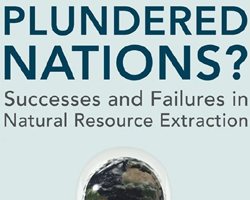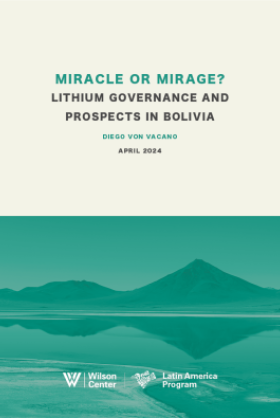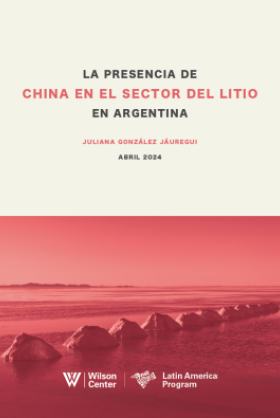Book Review: "Plundered Nations? Successes and Failures in Natural Resource Extraction"
In many resource rich countries, natural assets have not led to development. Plundered Nations?, edited by Paul Collier and Anthony Venables, lays out a series of decisions that need to be got “sufficiently right” for the depletion of natural assets to be converted into sustained development.

The original version of this article appeared on ECSP's blog, New Security Beat.
The principal argument of Plundered Nations? Successes and Failures in Natural Resource Extraction is highlighted by the question mark in the title. In many resource rich countries, natural assets have not led to development. The book advances the hypothesis that “for the depletion of natural assets to be converted into sustained development, a series of decisions has got to be got sufficiently right” (p. 1). That series of decisions is examined in detail through case studies on Cameroon, Chile, Iran, Kazakhstan, Malaysia, Nigeria, Russia, and Zambia, produced by a diverse group of academic and practicing economists under the auspices of the Centre for the Study of African Economies and the Oxford Centre for the Economics of Resource Rich Countries (OxCarre).
The editors of Plundered Nations are two of the leading economists working on the management of resource wealth. Paul Collier, through innovative and sometimes controversial work on conflict, democracy, and development, helped trigger the attention now being given to the “resource curse” thesis – the idea that mineral or oil wealth cannot be relied on to lead to economic development, stability, or democracy in developing countries. His co-editor, Anthony Venables, heads OxCarre, established in 2007 to become a global center of excellence in the economics of resource rich countries with a mandate to inform policy.
The introductory analysis by Collier and Venables describes the “key decisions” necessary to harness resource wealth for sustained economic development, and the country case studies explore in detail how each of these decisions has played out in each country and with what results.
Leveling the Information Playing Field
Deepwater drilling for oil and gas runs at over $500,000 a day; developing new mines and oil or gas fields can cost billions of dollars. In order to commit to this spending, investors’ licenses need to be secure; but to ensure that investors do not play competitive games to the detriment of government, license terms must also require that prospectors do actually invest in exploration within a relatively brief time period.
The first “key decision,” therefore, concerns setting up a proper investment regime. The importance of creating incentives for exploration and production is often neglected in policy analysis about how to avoid the resource curse. Here, the book provides very clear guidance to governments, and by implication, donors too: Governments should try to level the information playing field between them and extractive industry corporations by investing in as much public geologic information as is practicable. (This is where donors can, and do, help.) Then, the investment regime must be one that provides incentives for companies to (literally) sink capital into exploring for resources and turning finds into production.
Finally, the authors argue that governments should auction off exploration areas gradually to raise the prices paid and allow governments to claw back the risk premium embodied in early exploration.
Revenue Generation and Management
The second of the “key decisions” relates to taxation and the generation of revenues for governments. Here the authors cannot provide such a clear set of prescriptions. Instead, the book highlights general factors that should be taken into account when developing a tax regime, including geology (some resources are much more difficult – and costly – to extract than others) and built-in flexibility to changing commodity prices and other circumstances.
“A well designed tax regime,” they write, is “more dependent upon it being designed to anticipate changes in circumstances than it is to the niceties of the legal process” (p. 5).
Several of the case studies also look closely at the role of state companies as generators of revenues. In both Chile and Malaysia, state companies have been very effective, while, in contrast, the state company in Zambia came to not only “absorb all profits internally in the form of rising unit costs, but, by the time [the company] was dissolved, it was running at a loss equivalent to 10 percent of gross domestic product” (p. 5).
The case studies debunk two frequently voiced and contrasting stereotypes: one that national resource companies are essential to securing national benefit from resources, the other that they are inherently inefficient at capturing resource wealth. History shows that neither generalization is accurate – there have been successes and failures on both sides.
The discussion of government revenues also explores the problematic question of who gets resource revenues in divided countries and how resource revenues can be used to build peace rather than ferment conflict. From the profiles on Russia, Malaysia, and Nigeria in particular, the advice is clear and strong: assuming transparent and equitable motives, national governments should be given priority over local claims for disproportionate benefits.
The Challenge of Saving Prudently
The third “key decision” is on how government revenues are used, specifically how much to save.
Saving is needed both to smooth out the avoidable swings in revenues (because prices and production vary year to year) and to allow non-renewable resources (oil and minerals) to be steadily replaced with sustainable assets, but the various savings strategies analyzed in the case studies illustrate how difficult it is to get it right in practice.
The challenges are diverse. Cameroon’s savings strategy, initially widely praised, ended up failing completely. Secrecy, intended to forestall populist pressures for inappropriate domestic spending, and overseas investment, intended to help avoid “Dutch disease,” imploded into a mess of funds lost to corruption and politically driven local spending.
Kazakhstan appeared to being do everything right in terms of oil revenue savings, only to have things upturned as private sector loans, secured against the prudent management of the oil sector, generated an unsustainable property and construction bubble that required the carefully accumulated oil funds to be used to bail out banks.
One important conclusion drawn by the authors is to question the widely recommended practice of investing revenue funds in liquid assets overseas. The case studies illustrate that overseas assets can be too easily brought back to plug unanticipated gaps in home government budgets or to try and resolve political crises. The second lesson is the importance of building a common understanding across society of why some resource revenues are being saved – Chile and Botswana are cited as successful examples of this.
The Right Investments
After deciding how much of resource revenues should be saved, the final “key decision” governments face is what the remainder should be spent on and in what order. “Properly chosen, domestic investment can transform the economy away from resource dependence to a structure in which it is easier for ordinary citizens to generate productive livelihoods,” the authors write (p. 18).
Malaysia’s sequential investment in agriculture, for example, followed by manufacturing, and most recently in social sectors was a success. However, the Nigeria, Iran, and Kazakhstan case studies are reminders that managing domestic spending is difficult and the risk of white elephant projects that swallow excessive resources for little payoff is high.
In this context, Plundered Nations makes the important point that building capacity for public investment, improving the climate for private investment, and lowering the unit costs of construction are key areas to focus on (though exactly how to accomplish these goals will depend on the country in question). Priority actions might include improving port infrastructure; strengthening laws and enforcement capacity on public procurement; and/or expanding vocational training so that local workers are employed in the skilled construction trades.
Follow the Yellow Brick Road
The “key decisions” outlined throughout the case studies show that when resource-rich countries make sound choices (e.g. Malaysia and Chile), the results are seen in rapid economic growth accompanied by social peace. But where these inflection points are mishandled or ignored (e.g. Cameroon), the main legacy of extractive industry revenues is a deterioration of all social indicators.
Though the decisions track dominates the structure of the book, the authors highlight the role that individuals can play as well. The skill and integrity of the leaders of Malaysia’s state oil company; the courage and tenacity of Nigeria’s finance minister and a handful of other senior civil servants in turning around some of the country’s macro-economic management problems after 2003, including by securing debt relief – all were critical individual efforts.
Not for the Generalist
This is an extraordinarily interesting book, but it is also a difficult read. Unlike Paul Collier’s other policy-oriented books such as The Bottom Billion or Wars, Guns, and Votes, which are accessible to a reader new to the subject matter as well as informative for specialists, the target audience for Plundered Nationsis students, researchers, and policymakers working across development economics and natural resource economics, but some prior knowledge is assumed. For a reader new to these topics, I would suggest starting with the Nigeria case study. Nigeria’s experience up to 2003 illustrates the whole range of problems associated with natural resource extraction.
Also, though its breadth is valuable, I suspect I am not the only person who would have gotten more out of the book had a conclusion been added. The arguments made in Plundered Nations are consistent with theNatural Resource Charter, which the editors are deeply involved in. A conclusion that drew out this connection and pointed readers – especially policymakers – towards the charter would have been a logical finish and would, in any case, be a great addition for future editions.
Second, though the book touches on the varied results of different national companies, with new countries emerging as resource producers every year – consider Ghana, Mongolia, Tanzania, Uganda, and South Sudan (new country, old producer) – and national companies from Brazil, China, and Norway increasingly active internationally, it would be valuable to have a follow-up set of case studies that looks at the specific prerequisites for national resource companies to be successful in harnessing resource wealth for sustained economic development.
Despite these quibbles, Plundered Nations is essential reading for policymakers, students, and advisors who understand the risks of dependence on resource extraction and want to understand how they can be mitigated to ensure development rather than suffering.
Jill Shankleman is a senior scholar at the Woodrow Wilson Center and former senior social and environmental specialist at the World Bank. She now works as a consultant to multinational companies and banks, where her work focuses on oil, gas, and mineral extraction in developing nations.
Sources: Oil-Price.Net, Oxford Centre for the Economics of Resource Rich Countries.
Image Credit: Plundered Nations?: Successes and Failures in Natural Resource Extraction cover via Amazon.com.
About the Author

Jill Shankleman
Senior Social and Environmental Specialist, Multilateral Investment Guarantee Agency, World Bank

Environmental Change and Security Program
The Environmental Change and Security Program (ECSP) explores the connections between environmental change, health, and population dynamics and their links to conflict, human insecurity, and foreign policy. Read more

Environmental Change and Security Program
The Environmental Change and Security Program (ECSP) explores the connections between environmental change, health, and population dynamics and their links to conflict, human insecurity, and foreign policy. Read more









